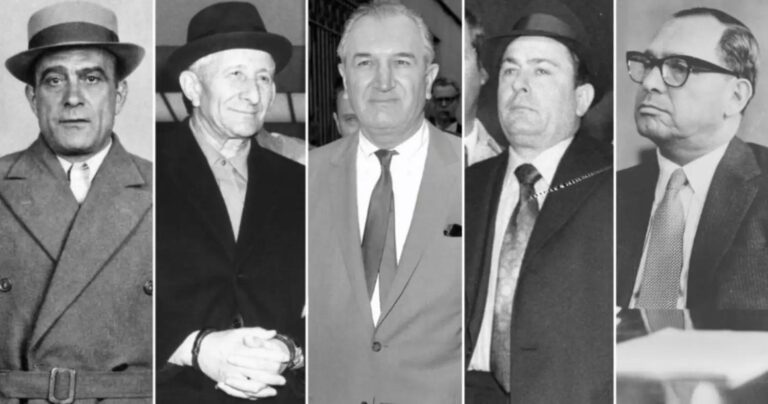The Mafia’s “Five Families” have long been synonymous with organized crime in New York City, shaping the underworld landscape throughout the 20th century and beyond. A cornerstone of the American Mafia, these five powerful crime syndicates wielded immense influence over illegal enterprises such as gambling, racketeering, and extortion. This article explores the origins, key figures, and lasting legacy of the Five Families, shedding light on how they earned their notorious place in criminal history.
Origins and Rise of the Mafia’s Five Families in New York
In the early 20th century, New York City’s criminal underworld was a patchwork of gangs, but the landscape dramatically shifted during the Prohibition era. The resulting demand for illegal alcohol distribution catalyzed the emergence of organized crime groups that eventually coalesced into the Five Families. Rooted in Italian immigrant communities, these factions evolved from fragmented street gangs into powerful syndicates controlling distinct territories across the city. Each family developed its own network of illicit operations ranging from bootlegging and extortion to gambling and labor racketeering, securing influence not only in criminal circles but also local politics.
By the 1930s,the five families had established a structured hierarchy,adopting the classic Mafia governance model,complete with a boss,underboss,consigliere,and a series of capos managing crews. This association facilitated stability and cooperation, minimizing violent turf wars and allowing for expansive collaboration. Their dominance reshaped New York’s criminal economy and left an indelible mark on American history. Key elements of their legacy include:
- The Original Families: Bonanno, Colombo, Gambino, Genovese, Lucchese.
- Territorial Divisions: Borough-based control over Manhattan, Brooklyn, Queens, The Bronx, and Staten Island.
- Criminal Specializations: Bootlegging, loan sharking, illegal gambling, labor racketeering.
- Influence: Deep infiltration into unions, local government, and legitimate businesses.
| Family | Original Founder | Primary Territory | Known for |
|---|---|---|---|
| Bonanno | Joseph Bonanno | Brooklyn | Bootlegging, narcotics |
| Colombo | Joseph Profaci | Brooklyn, Queens | Extortion, loan sharking |
| Gambino | Carlo Gambino | Manhattan | Labor racketeering |
| Genovese | Charles “Lucky” Luciano | The Bronx | Illegal gambling, political influence |
| Lucchese | Tommy Lucchese | Manhattan, Brooklyn | Racketeering, narcotics |
Key Figures and Power Struggles Within the Five Families
At the heart of the Five Families’ dominance in New York City lay a collection of formidable figures whose ambitions and rivalries shaped the deadly chessboard of organized crime. Leaders such as Charles “Lucky” Luciano of the Genovese family and Vito Genovese, his successor, were architects of the modern Mafia hierarchy, orchestrating alliances and betrayals with cold calculation.The Gambino family, under the reign of Carlo Gambino and later John Gotti, became synonymous with both brutal enforcement and high-profile media attention. Meanwhile, the Lucchese, Colombo, and Bonanno families saw their own turbulent leadership battles, each vying for control over lucrative rackets and drug trafficking routes.
The resulting power struggles often turned deadly, igniting a volatile mix of loyalty and treachery. Famously, internal conflicts sparked waves of violence, including the infamous Castellammarese War in the early 1930s, which ultimately cemented the Commission—a governing body to regulate disputes among families. Even as the Commission maintained a fragile peace, assassinations and betrayals were frequent tools of survival. Below is a quick reference of key figures and their notorious roles within the Five Families:
| Family | Notable Leader | Known For |
|---|---|---|
| Genovese | Charles “Lucky” Luciano | Modern Mafia structure, Commission founder |
| Gambino | John Gotti | Media spotlight, ruthless enforcement |
| Lucchese | Anthony “Tony Ducks” Corallo | Skilled strategist, organized labor control |
| Colombo | Joseph Colombo | Public Mafia advocacy, internal feuds |
| Bonanno | Joseph Bonanno | Long tenure, internal family schisms |
Impact of Law Enforcement on Mafia Operations Over the Decades
Over the decades, law enforcement efforts have dramatically reshaped the operations of the Mafia. Early attempts often faltered due to corruption,limited resources,and a code of silence known as omertà. Though, the introduction of federal laws such as the RICO (Racketeer Influenced and Corrupt Organizations) Act in 1970 marked a turning point. This legislation empowered prosecutors to target entire criminal organizations rather than just individuals, enabling more comprehensive crackdowns on the Mafia’s intricate network of illegal activities. High-profile trials and convictions throughout the 1980s and 1990s severely disrupted the control and influence of the Five Families, destabilizing their traditional hierarchies.
- Enhanced Surveillance: Deployment of wiretaps and undercover operations exposed inner workings.
- Financial Investigations: Tracing money laundering activities cut off essential revenue streams.
- Witness Protection Programs: Encouraged insiders to break silence and testify.
- Inter-agency Collaboration: Greater cooperation between FBI, local police, and federal agencies.
These concerted efforts have not eradicated the Mafia but have forced it into a more covert operating mode.The families have adapted by diversifying their enterprises and reducing overt violence to avoid law enforcement detection. Despite these shifts, the law enforcement community remains vigilant, constantly evolving its strategies to counter the Mafia’s enduring influence. The resulting dynamic is a high-stakes chess game, with authorities aiming to disrupt the organization as it continues to adjust to new challenges.
| Decade | Key Law Enforcement Development | Effect on Mafia |
|---|---|---|
| 1970s | RICO Act Enacted | Enabled prosecutions of entire organizations |
| 1980s | High-profile Trials | Disrupted leadership of the Five Families |
| 1990s | Witness Protection Expansion | Increased insider testimonies |
| 2000s-Present | Advanced Surveillance Tech | More covert operational tactics by Mafia |
Strategies for Understanding and Preventing Organized Crime Today
Modern approaches to dismantling organized crime rely heavily on interdisciplinary efforts that combine law enforcement, community engagement, and advanced technology. Understanding the intricate social networks and financial flows within criminal organizations is crucial. By mapping out leadership structures, supply chains, and money laundering operations, authorities can strategically target key vulnerabilities. Technologies like data analytics, surveillance drones, and blockchain tracing allow law enforcement to anticipate criminal moves and intercept illicit activities before they escalate.
Prevention strategies have evolved beyond mere policing to include robust community programs that address the socio-economic root causes often exploited by organized crime groups. Educational initiatives, youth mentorship, and job creation serve as buffers against recruitment. Collaborative task forces that include both domestic and international agencies enhance intelligence sharing and operational coordination.The following table highlights some of these tools and programs currently shaping the fight against organized crime:
| Strategy | Purpose | Impact |
|---|---|---|
| Data Analytics | Identify patterns & networks | Targeted prosecutions |
| Community Outreach | Reduce recruitment | Lower crime rates |
| Multinational Task Forces | Coordinate operations | Disrupt transnational crime |
| Financial Tracking | Trace illicit funds | Freeze assets |
Wrapping Up
The legacy of the Mafia’s Five Families remains a important chapter in the history of organized crime in America. Their influence, marked by both ruthlessness and a strict code of conduct, shaped the underworld’s operations for decades and left an indelible mark on law enforcement efforts. While modern times have seen changes in their power dynamics, the stories of these families continue to fascinate and caution, serving as a reminder of the complex interplay between crime, culture, and society. Understanding their origins and impact offers crucial insight into one of the most notorious criminal enterprises in U.S. history.




